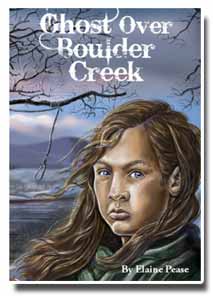PeasePod Books
Book Reviews
Ghost Over Boulder Creek
Here's what readers are saying
 Filled with the colorful characters that made up the Westward Movement, “Ghost Over Boulder Creek” takes young readers back to 1868, when cultures clashed and Manifest Destiny ruled. But one boy defies the odds to save his mother, his people, and prove his bravery as a Cheyenne.
Filled with the colorful characters that made up the Westward Movement, “Ghost Over Boulder Creek” takes young readers back to 1868, when cultures clashed and Manifest Destiny ruled. But one boy defies the odds to save his mother, his people, and prove his bravery as a Cheyenne.
"... After Father taken away, the Cheyenne pushed from reservation to reservation. He would not know Tsitsistas in Oklahoma Territory on the Washita.” He wanted to smile confidence but something caught his attention, something that swirled in the dusty sunbeam behind the two men. Was it his spirit guide? Was it a ghost? Then, it disappeared, with a sudden tent rattling breeze, and a moan that could have been the wind but still raised bumps on Run Through Fire’s arms.”
When Run Through Fire’s white father is accused of stealing horses and taken away by white men, Run Through Fire knows he must protect his Cheyenne mother. Though both survive the terrible Washita River Massacre upon their Cheyenne people, they are captured and his mother is sent to prison. General Custer believes Run Through Fire is a captive white boy raised by the Cheyenne. Run Through Fire pretends it’s true to stay alive in the white man’s world and he and Buffalo Bill journey across the Oklahoma plains toward newly settled Boulder in Colorado Territory, to find Run Through Fire’s father. After he arrives in Boulder, ghostly images that have haunted Run Through Fire during his journey, prove to be more than warnings.
Click here to read entire article
____________________________________________________
“... Pease has written an excellent novel full of ghostly spirits of
the past, filled with mystery and Cheyenne trails.”
Gordon Yellowman, Cheyenne Indian Chief
_____________________________________________________
“...
When I received this manuscript I just couldn’t put it down-
it is stories like this that turn kids into readers.”
Cathy Morrison, illustrator
_____________________________________________________
Glossary of terms used in Ghost over Boulder Creek
Count coup When an Indian touched or struck the white man or a hunted animal, he counted coup. This was the highest act of bravery.
Dog Soldiers These braves were more ferocious than other braves. They were called Dog Soldiers because chien (which is French for dog) sounds like Cheyenne.
E-peva e Thank you.
Heammawihio The wise one above, the creator.
Hō ĭm´ ă hă A being who appears in a white cloud and brings winter.
Maheó God
Major Wynkoop Indian agent who represented and was sympathetic to the Cheyenne and Arapahoe. He was outraged after the Washita Massacre and resigned afterward.
Manifest Destiny A belief that the North American continent belonged to whites and that they were ordained by God to create a model society. The government decided to protect wagon trains moving westward by dividing Indians into reservations.
Mis´tai Owl messenger to the Cheyenne. Owl hooting warns of danger or that one of their people has died.
Nōtŭm´ The north, where the cold wind comes from.
Pemmican Boiled and pounded dried fruit or meat. Heated in buffalo fat.
Portmanteau A travel bag.
Sand Creek Massacre November 29, 1864, Col. Chivington attacks a Cheyenne camp on the Sand Creek in Colorado, brutally killing over 200 men, women and children.
Santa Fe Trail An important trade route between Independence, Missouri and Santa Fe, New Mexico.
Satchel A small bag.
Squaw Indian woman. Now, the term is considered offensive and not used.
Travois Type of sled pulled by horses or dogs.
Tsitsista What the Cheyenne called themselves.
Washita River Massacre- November 27, 1868, Gen. Custer leads the 7th Cavalry to attack a peaceful Cheyenne village camped along the Washita River in Oklahoma, killing approximately 150 Cheyenne.
Wīhio White man, spider, one of superior intelligence.
Winter Campaign Custer’s plan to pursue the fleeing bands of Indians over the winter of 1868 to 1869.






 Ghost Over Boulder Creek
Ghost Over Boulder Creek